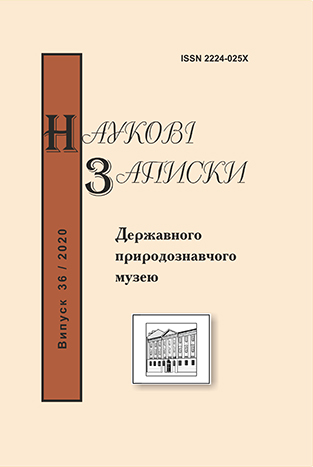Main
/
/
Serediuk G.V.
Altitude and biotope distribution of species of a number of Neuroptera fauna of the Ukrainian Carpathians and the Transcarpathian lowlands.// Proc. of the State Nat. Hist. Mus. - Lviv, 2020. - 36. - P. 147-158. DOI: https://doi.org/10.36885/nzdpm.2020.36.147-158 Key words: net-winged insects, Neuroptera, Ukrainian Carpathians, Transcarpathian lowland, fauna The species composition of the net-winged insects fauna, as well as the biotope distribution within the territory of the Ukrainian Carpathians have been studied.
For the first time, an altitude-band analysis of the distribution of net-winged insects in the Ukrainian Carpathians was conducted, which showed that the highest species diversity is characterized by the belt of oak forests, for which 50 species of reticulated net-winged insects are listed. Seven were found to be original for the belt: Chrysopa hummeli, Chrysopa dorsalis, Chrysopa hungarica, Chrysopa nigricostata, Sisyra nigra, Distoleon tetragrammicus, Libelloides macaronius. These species occur only in this zone and are very rare. It was found that the highest species diversity is characterized by mixed forests and forest edges, for which 39 species were identified, which is 78% of the total number of species that occur in the belt of oak forests. The highest Magralef index for mixed oak forests (Quercus, Tilia, Acer, Fraxinus, Ulmus, etc.).
For the belt of beech forests, there are 43 species. It was found that the greatest species diversity is characterized by forest edges, there are 32 species, which is 74% of the total number of species of beech belt of the Ukrainian Carpathians, 31 species (72%) in beech forest with admixtures of other deciduous trees. 29 on the edges and in the old beech forests (virgin forests). The highest index of species richness according to Margalef falls on the edges.
As part of the spruce forest belt, 24 species were noted, ten of which, namely Wesmaelius mortoni, Wesmaelius nervosus, Wesmaelius ravus, Wesmaelius tjederi, Wesmaelius concinnus, Wesmaelius quadrifasciatus, Hemerobius contumax, Hemerobius feumax, Hemerobius fenestih only within the belt of spruce forests. Margalef's highest index characterizes young spruce forests.
In the subalpine zone, only four species of reticulated net-winged insects were found – Myrmeleon formicarius, Wesmaelius nervosus, Wesmaelius ravus and Chrysoperla carnea, in the alpine zone – none.
Altitude and biotope distribution of species of a number of Neuroptera fauna of the Ukrainian Carpathians and the Transcarpathian lowlands.// Proc. of the State Nat. Hist. Mus. - Lviv, 2020. - 36. - P. 147-158. DOI: https://doi.org/10.36885/nzdpm.2020.36.147-158 Key words: net-winged insects, Neuroptera, Ukrainian Carpathians, Transcarpathian lowland, fauna The species composition of the net-winged insects fauna, as well as the biotope distribution within the territory of the Ukrainian Carpathians have been studied.
For the first time, an altitude-band analysis of the distribution of net-winged insects in the Ukrainian Carpathians was conducted, which showed that the highest species diversity is characterized by the belt of oak forests, for which 50 species of reticulated net-winged insects are listed. Seven were found to be original for the belt: Chrysopa hummeli, Chrysopa dorsalis, Chrysopa hungarica, Chrysopa nigricostata, Sisyra nigra, Distoleon tetragrammicus, Libelloides macaronius. These species occur only in this zone and are very rare. It was found that the highest species diversity is characterized by mixed forests and forest edges, for which 39 species were identified, which is 78% of the total number of species that occur in the belt of oak forests. The highest Magralef index for mixed oak forests (Quercus, Tilia, Acer, Fraxinus, Ulmus, etc.).
For the belt of beech forests, there are 43 species. It was found that the greatest species diversity is characterized by forest edges, there are 32 species, which is 74% of the total number of species of beech belt of the Ukrainian Carpathians, 31 species (72%) in beech forest with admixtures of other deciduous trees. 29 on the edges and in the old beech forests (virgin forests). The highest index of species richness according to Margalef falls on the edges.
As part of the spruce forest belt, 24 species were noted, ten of which, namely Wesmaelius mortoni, Wesmaelius nervosus, Wesmaelius ravus, Wesmaelius tjederi, Wesmaelius concinnus, Wesmaelius quadrifasciatus, Hemerobius contumax, Hemerobius feumax, Hemerobius fenestih only within the belt of spruce forests. Margalef's highest index characterizes young spruce forests.
In the subalpine zone, only four species of reticulated net-winged insects were found – Myrmeleon formicarius, Wesmaelius nervosus, Wesmaelius ravus and Chrysoperla carnea, in the alpine zone – none.
References
- Lesnaia entomologiia / red. Gusev V. N. – Moskva : Goslesbumizdat, 1961. – 232 s. [In Russian]
- Lisy Zakarpattia. Suchasnyi stan, vykorystannia ta okhorona / Fedurtsia I. Yu., Pecher I. I., Kichura V. P., Krichfalushii V. V., Sabadosh V. I., Krochko Yu. I., Luhovoi O. – Uzhhorod, 1997. – 55 s. [In Ukrainian]
- Malynovskyi A. K. Vysotnyi rozpodil roslynnoho pokryvu Ukrainskykh Karpat // Nauk. zap. Derzh. pryrodozn. muzeiu. – 2002. – T. 17. – S. 33-42. [In Ukrainian]
- Malynovskyi K. A. Vysokohirna roslynnist Ukrainskykh Karpat. –Kyiv : Nauk. dumka, 1980. – 278 s. [In Ukrainian]
- Opredelitel vysshikh rastenii Ukrainy / red. Dobrochaeva D. N., Kotov M. I., Prokudin Iu. N. i dr. – Kiev : Fitosotciotcentr, 1999. – 548 s. [In Russian]
- Popov M. G. Ocherk rastitelnosti i flory Karpat Moskva : Izd-vo Moskovskogo obshchestva ispytatelei prirody, 1916. – S. 35-79. [In Russian]
- Chubatyi O. V. Hirski lisy – rehuliatory vodnoho rezhymu. – Uzhhorod : Karpaty, 1984. 102 s. [In Ukrainian]


